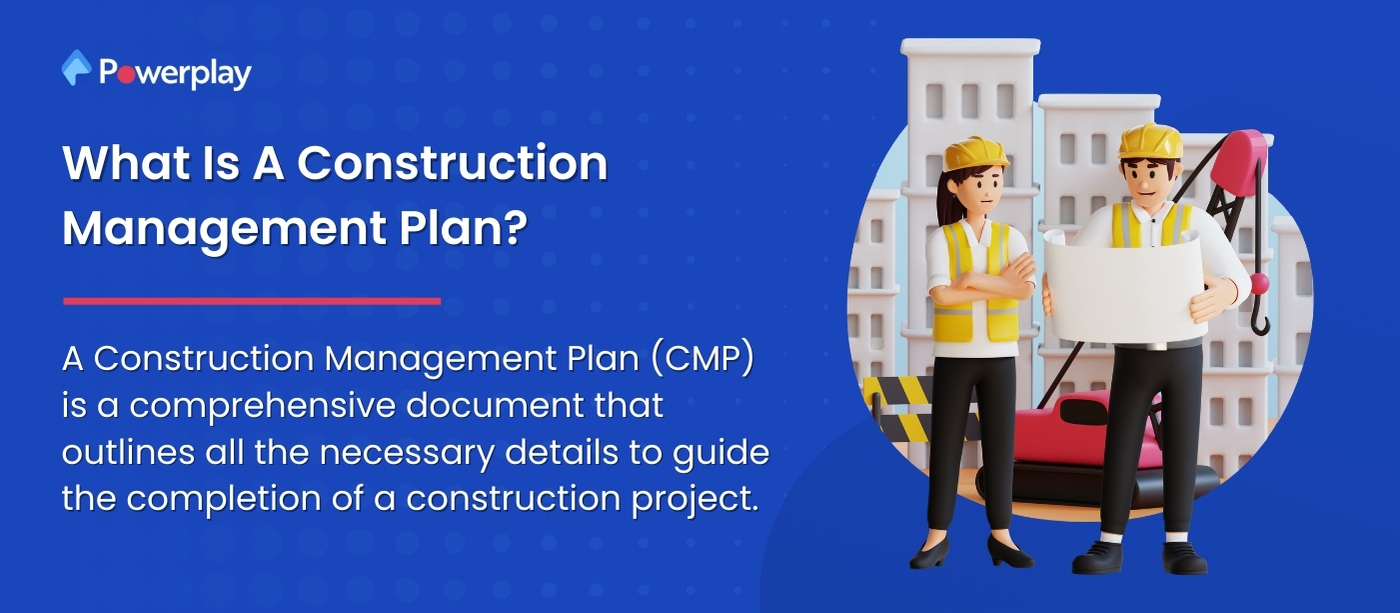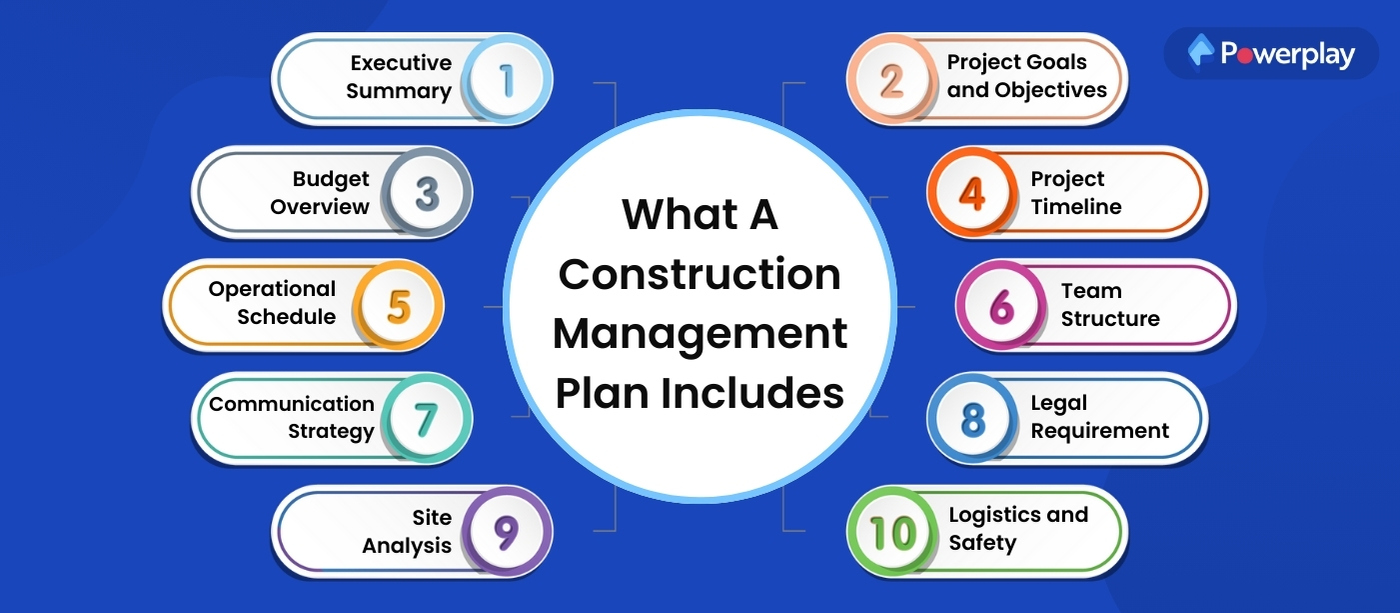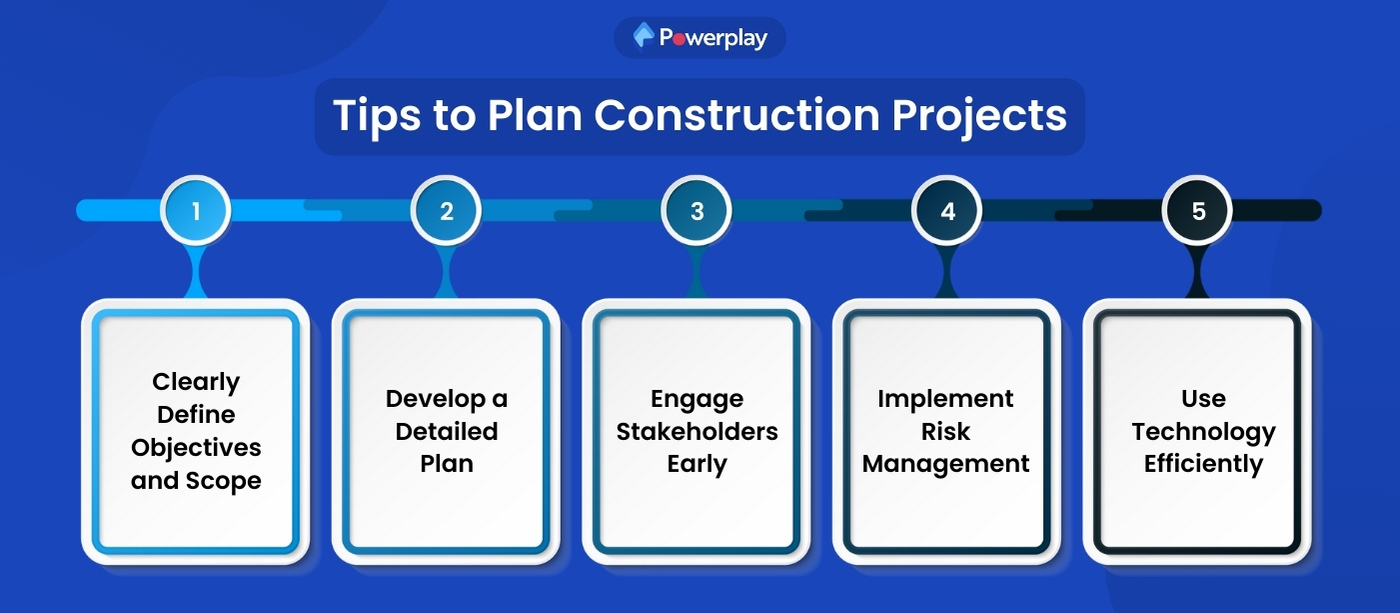How To Create a Construction Management Plan
-
Sapna
- June 28, 2024

A Construction Management Plan (CMP) serves as the guiding document for overseeing every facet of a construction project, ensuring it achieves its objectives with maximum efficiency and effectiveness. This blog aims to guide you through the fundamental process of developing a CMP, covering key steps such as defining project goals, assembling a competent team, and implementing strong management strategies.

Whether you are an experienced construction project manager or new to the field, mastering the art of crafting a thorough CMP is essential for successfully executing any construction endeavour.
Table of Contents
What Is A Construction Management Plan?

A Construction Management Plan (CMP) is a comprehensive document that outlines all the necessary details to guide the completion of a construction project. It includes information on project goals, deliverables, schedules, budgets, and resource allocation, ensuring that all aspects of the construction project management are well-coordinated and executed efficiently.
This plan is critical for managing the project’s technical and operational sides, bridging communication gaps between various teams, and maintaining a clear path toward project objectives. It typically addresses key areas such as scope, schedule, budget, quality, resources, and risk management. A CMP also involves detailed planning for safety measures, environmental impacts, and community interactions, especially when the project is likely to affect the surrounding area. Overall, the construction management plan is essential for making sure that the project is completed on time, within budget, and to the required quality standards while managing the project and monitoring potential risks and impacts.
What Is the Aim of a Construction Management Plan?
The aim of a Construction Management Plan (CMP) is to provide a comprehensive and detailed framework for managing all phases of a construction project. This plan is essential for the project team, regulatory bodies, and other stakeholders, ensuring that everyone involved in managing construction projects has access to the key information necessary for the successful execution of the project. The CMP outlines the client’s objectives and expectations, guiding the construction process through its various stages—pre-construction, construction, and post-construction.
The CMP is dynamic and can be revised and updated as the project evolves, accommodating new data and adjustments needed due to changes in project scope or unforeseen challenges. This iterative nature allows the CMP to remain relevant and useful throughout the project’s life.
It is important to differentiate the CMP from the Construction Phase Plan, which is focused specifically on health and safety management and is a statutory requirement under certain regulations like the Construction Design & Management Regulations. The Construction Phase Plan is generally authored by the Principal Contractor. It contains detailed health and safety protocols integrated into the CMP to ensure comprehensive coverage resource management of all project aspects.
What Does A Construction Management Plan Includes

Creating a comprehensive Construction Management Plan (CMP) is crucial for successfully executing a construction project. Here’s a structured outline of what typically should be included in an effective construction industry CMP:
- Executive Summary: This part provides a brief of the project, including its purpose, scope, and approach to managing the construction. It should answer the project’s what, why, where, and how.
- Project Goals and Objectives: Clearly define what the client and construction team aim to achieve, setting clear and measurable targets.
- Budget Overview: Detail the financial outline, including the total budget, allocation for different phases, and contingency plans for unforeseen expenses.
- Project Timeline and Phases: Outline the schedule, breaking the project into phases, tasks, and subtasks. This section should be flexible to accommodate changes and agile in approach.
- Operational Schedule: To ensure smooth operations, include details on construction hours, policies on overtime and night work, and specifics of on-site deliveries.
- Team Structure: List all team members and their roles and responsibilities. This helps establish clear lines of accountability and communication.
- Communication Strategy: Develop a plan for handling communication before, during, and after construction to ensure all stakeholders are well-informed.
- Legal and Regulatory Requirements: Document all necessary permits and regulatory requirements, such as street occupancy, blasting permits, and adherence to building codes.
- Site Analysis: Provide detailed site descriptions supported by maps, photographs, and setup plans. This will guide logistical arrangements and site setup.
- Logistics and Safety Management: Establish protocols for traffic management, emergency procedures, fire prevention, waste management, and environmental controls to ensure safety and compliance with regulatory standards.
What should go into a construction management plan?
A well-structured construction management plan should encompass the following elements:
- Project Overview: Provide a summary detailing the project’s nature, objectives, and approach to management, including why it’s necessary, where it will occur, and how operations will be conducted.
- Goals and Objectives: Outline what the clients and construction team aim to achieve throughout the project.
- Financial Plan: Include detailed budgets and contingency strategies for handling unforeseen expenses.
- Project Timeline: Develop a timeline incorporating agile methodologies, detailing all project phases, tasks, and subtasks.
- Operational Schedule: Specify operational details such as allowed working hours, policies on overtime, night operations, and delivery logistics.
- Roles and Responsibilities: Mention the roles and responsibilities of all team members to ensure clear accountability.
- Communication Strategy: Establish a communication protocol before, during, and after the project to keep all stakeholders informed and engaged.
- Compliance and Permits: List all necessary legal and project-specific requirements, including permits needed for street occupancy, blasting, and adherence to building codes.
- Site Information: Provide comprehensive descriptions, maps, photos, and set-up layouts of the construction site.
- Safety and Logistics: Address logistical challenges and safety protocols, including traffic management, emergency procedures, fire prevention, waste management, and environmental protection.
- Community and Cultural Considerations: Consider the impact on local communities and cultural heritage, ensuring compliance with relevant zoning and community relations.
Construction Project Planning Steps

Here are the key steps you need to follow to a structured construction project planning:
Scope Documentation:
Define the project’s scope comprehensively, including all inputs from stakeholders and clients to outline the project’s goals, benefits, and overall purpose. Detail the project charter, the roles, responsibilities, and expectations of every team member, along with the project’s financials, timelines, and methods.
Work Breakdown Structure (WBS):
Develop a WBS to organise the various project tasks into smaller, manageable tasks. This step helps assign the appropriate resources to each task efficiently, enhances workload management across the project, and facilitates progress tracking for timely interventions.
Feasibility Study:
Evaluate the project’s critical environmental, social, and financial aspects to identify potential impacts and profitability of a successful project. This analysis is crucial to determining the project’s viability and anticipating any significant challenges that might arise.
Cost and Time Analysis:
Conduct a detailed analysis of the expected costs and the project timeline. This involves calculating all associated costs and scheduling resources to ensure the project can be delivered on budget and time. Regular updates and adjustments to this plan can help keep project costs and mitigate the risk of delays and cost overruns.
Quality Control and Risk Management:
Implement rigorous project quality control measures to ensure adherence to agreed standards and specifications. Develop a thorough risk management strategy to identify, evaluate, and address risks throughout the project lifecycle, ensuring maintenance of safety and quality standards.
Communication Plan Documentation:
Outline a clear communication strategy to ensure seamless interaction among construction project managers and all departments and stakeholders. This plan should specify the communication channels, frequency of updates, and protocols for addressing any issues, ensuring that the construction project remains on track and that all teams are aligned with the project objectives.
Who creates construction management plans?
Construction management plans (CMPs) are typically developed by project managers or construction managers. These professionals can either be independent contractors or part of the construction company’s team. Their main responsibility is to plan, organise, direct, control, and coordinate the various construction activities of projects involving both physical and human resources.
Creating a CMP involves a collaborative approach. Project managers work closely with various stakeholders, such as architects, engineers, contractors, and clients, to meet all project requirements. This collaborative process helps craft a plan that addresses all aspects of the construction project, from initial construction planning and design to completion and handover.
The CMP serves as a key document for all project participants, ensuring everyone is aligned with the project’s goals, timelines, and compliance with relevant regulations and standards.
Who uses construction management plans?
Construction management plans (CMPs) are utilised by various groups involved in building projects. Clients use these plans to set clear goals and ensure everyone on the team is aligned. Construction managers use their knowledge to guide the execution of the plan, contributing their expertise where necessary. On the ground, the construction crews and workers refer to the CMP to stay updated on their tasks and track the project’s progress. Finally, stakeholders such as investors or regulatory bodies review and approve the plans, keeping informed of any changes or updates as the project evolves. These plans are essential for maintaining organised and efficient progress from start to finish.
What to leave out of a construction management plan
When creating a construction project management plan, it’s best to exclude unconfirmed ideas, informal stakeholder feedback, and overly rigid rules that limit flexibility. Avoid including speculative elements that might change. Detailed financial data and sensitive personal information should also be kept out to protect privacy and security. Focus on including only verified, essential details that contribute to the efficient management and execution of the project.
Tips to plan construction projects

Here are five key tips for effectively planning construction projects:
Clearly Define Objectives and Scope:
Establish clear objectives and a detailed project scope. This will ensure that all team members understand what needs to be accomplished and help prevent scope creep.
Develop a Detailed Plan:
Create a comprehensive project plan that includes timelines, resource allocation, and budgeting. Use tools like Gantt charts to visualise the project timeline and critical milestones.
Engage Stakeholders Early:
Involve all key stakeholders early in the planning process to gather input and align expectations. This can include investors, community members, and regulatory bodies.
Implement Risk Management:
Identify potential risks early in the project and develop mitigation strategies. Regularly review and adjust these strategies as the project progresses.
Use Technology Efficiently:
Leverage construction and project management software for better coordination, communication, and progress tracking. These tools can help streamline operations and keep the project on track.
How to make a construction management plan with Powerplay

Creating a construction management plan with Powerplay involves leveraging its suite of integrated features designed to enhance the efficiency and effectiveness of managing construction projects. Here’s a step-by-simplified process:
Project Initialisation: Begin by defining the scope, objectives, and stakeholders’ requirements using Powerplay’s project charter tools. This sets a clear foundation for the entire project.
Detailed Planning: Utilise Powerplay’s project planning features to outline tasks, schedules, budgets, and resources. The software’s Gantt charts and resource allocation tools allow for detailed and dynamic planning.
Execution and Tracking: During the execution phase, Powerplay enables real-time tracking of progress and resources. You can access live site images, track dynamic progress, and receive instant updates on blockers, ensuring that all activities align with the project plan.
Communication and Collaboration: Powerplay enhances communication among team members and stakeholders through integrated messaging and document sharing features. This ensures everyone is aligned and informed throughout the project lifecycle.
Monitoring and Control: Keep the project on track with Powerplay’s monitoring tools. Real-time dashboards provide actionable insights, helping you manage tasks and materials efficiently and respond quickly to any deviations from the plan.
Project Closeout: As the project concludes, use Powerplay to finalise all activities, evaluate performance against initial targets, document lessons learned, and prepare final reports. This phase ensures all contractual obligations are met and the project is successfully handed over.
Conclusion
Crafting a Construction Management Plan is an integral step towards steering a construction project towards success. This guide has equipped you with the foundational knowledge to develop a construction management plan outlines one that not only outlines the scope and objectives but also strategically addresses the complexities of managing time, cost, and quality. By integrating these principles and adapting to the unique demands of your project, you can ensure robust project execution. Remember, the effectiveness of a Construction Management Plan lies in its clarity and the collaborative effort of the entire project team. Let this be your roadmap to navigating the challenges of construction management and achieving project excellence.













